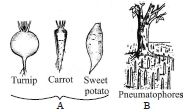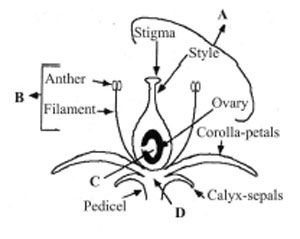The given figure shows the parts of mango and coconut. Choose the option which shows the correct labelling of A, B, C and D marked in the figures.

A - Epicarp, B - Mesocarp, C - Seed, D - Endocarp
A - Epicarp, B - Mesocarp, C - Ovule, D - Endocarp
A - Epicarp, B - Mesocarp, C - Ovary, D - Endocarp
A - Epicarp, B - Mesocarp, C - Embryo, D - Endocarp
Correct Answer :
A. A - Epicarp, B - Mesocarp, C - Seed, D - Endocarp
In mango and coconut, the fruit is known as drupe. Drupe develops from monocarpellary superior ovaries. In mango, the pericarp is differentiated into an outer thin epicarp, middle fleshy edible mesocarp and an inner stony hard endocarp. In coconut, the mesocarp is represented by the fibrous part.
Related Questions
In which of the following plants, a slender lateral branch arises from the base of the main axis and after growing aerially arch downwards to touch the ground?
Mint and jasmine
Banana and pineapple
Grass and stawberry
Pistia and Eichhornia
Ginger is an underground stem. It is distinguished from root because
it lacks chlorophyll.
it stores food.
it has nodes and internodes.
it has xylem and vessels.
The region of the stem where leaves are born are called ____________ while ____________ are the portions between two ____________.
nodes, nodes and internodes
nodes, internodes and nodes
internodes, nodes and nodes
internodes, internodes and nodes
A scar on the seed coat through which the developing seeds attached to the fruit is called as ________.
testa
tegmen
hilum
micropyle
The given figures (A and B) shows the modificaiton of roots.Which of the following statements regarding the figures is correct ?

Tap roots of carrot, turnip and adventitious root of sweet potato, get swollen and store food.
Pneumatophores conducts water, minerals & photosynthesis
Pneumatophore is found in the plants that grow in sandy soil.
Turnip & carrot shows adventitious roots and sweet potato shows tap root.
Prop roots of banyan tree are meant for
respiration.
absorption of water from soil.
providing support to big tree.
all of the above.
Match column-I with column-II and choose the option which shows their correct combination.
| Column-I | Column-II |
|---|---|
| A. Gamosepalous | I. Flower of lily |
| B. Polysepalous | II. Sterile anther |
| C. Gamopetalous | III. Free petals |
| D. Polypetalous | IV. Free sepals |
| E. Epiphyllous | V. Fused petals |
| F. Staminode | VI. Fused sepals |
A IV, B V, C III, D I, E VI, F II
A IV, B III, C V, D I, E II, F VI
A VI, B IV, C III, D V, E I, F II
A VI, B IV, C V, D III, E II, F I
Which of the following statement(s) is /are correct?
- Many plants belong to family fabaceae are good ornamentals (Tulip, Gloriosa), source of medicine (Aloe) and vegetables (Asparagus).
- The plumule and radicle are enclosed in sheaths which are called coleorhiza and coleoptile respectively.
- A flower having either only stamens or only carpels is unisexual.
- Basal, alternate, linear, exstipulate with parallel venation types of leaves is found in the family liliaceae.
Only (i)
Both (i) and (ii)
Both (iii) and (iv)
All of these
How many plants in the list given below have marginal placentation?
- Mustard
- Gram
- Tulip
- Asparagus
- Arhar
- Sunhemp
- Chilli
- Colchicine
- Onion
- Moong
- Pea
- Tobacco
- Lupin
Four
Five
Six
Three
Match the column-I containing types of aestivation with their examples given in column-II and choose the correct option.
| Column - I | Column-II |
|---|---|
| (Type of aestivation) | (Examples) |
| A. Valvate | I. Cotton |
| B. Twisted | II. Calotropis |
| C. Imbricate | III. Bean |
| D. Vexillary | IV. Gulmohar |
A I; B II; C IV; D III
A II; B I; C IV; D III
A II; B IV; C I; D III
A II; B I; C III; D IV
A branch in which each node bearing a rossette of leaves and a tuft of roots is found in aquatic plants like _________ and _________.
Hydrilla and Pistia
Eichhornia and Hydrilla
Pistia and Eichhornia
Pistia and Vallisneria
Cotyledons and testa respectively are edible parts in which of the following group?
walnut and tamarind
cashew nut and litchi
french bean and coconut
groundnut and pomegranate
Match column-I with column-II and choose the correct option.
| A. Gram, sem, moong, | I. Medicine soyabean |
|---|---|
| B. Soyabean,groundnut | II. Ornamental |
| C. Indigofera | III. Fodder |
| D. Sunhemp | IV. Fibres |
| E. Sesbania, Trifolium | V. Dye |
| F. Lupin, sweet potato | VI. Edible oil |
| G. Mulethi | VII. Pulses |
A I, B II, C III, D IV, E V, F VI, G VII
A VII, B VI, C V, D IV, E III, F II, G I
A II, B IV, C VI, D I, E III, F V, G VII
A I, B III, C V, D VII, E II, F IV, G VI
Which one of the following structure is not associated with gynoecium?
Ovary
Style
Stigma
Filament
Which one of the following option shows the correct labelling of the structure marked as A, B, C & D?

A - Gynoecium, B - Megasporophyll, C - Ovule, D - Thalamus
A - Gynoecium, B - Stamen, C - Seed, D - Thalamus
A - Microsporophyll, B - Stamen, C - Ovule, D - Thalamus
A - Gynoecium, B - Stamen, C - Ovule, D - Thalamus
Which of the following is an example of pinnately compound leaf ?
Cucumber
Papaya
Cucurbita
Neem
Statement 1 : A simple leaf has undivided lamina.
Statement 2 : Leaves showing pinnate and palmate venations have various type of incisions.
Statement-1 and statement-2 are true and statement-2 is a correct explanation for statement -1.
Statement -1 and statement -2 are true but statement-2 is not a correct explanation for statement-1.
Statement-1 is true and statement-2 is false.
Both the statements are false.
When a flower has both androecium and gynoecium, it is known as__________.
asexual
bisexual
unisexual
multisexual
The given figure shows a typical structure of monocotyledonous seeds. Identify A, B, C, D and E parts marked in the given figures.

A - Endosperm, B - Embryo, C - Scutellum, D - Coleorhiza, E - Coleoptile
A- Embryo, B - Endosperm, C - Scutellum, D - Coleoptile, E - Coleorhiza
A - Endosperm, B - Embryo, C - Scutellum, D - Coleoptile, E - Coleorhiza
A - Embryo, B - Endosperm, C - Scutellum, D - Coleorhiza, E - Coleoptile
The primary roots and its branches constitute the
fibrous root system.
tap root system.
adventitious root system.
all of the above
The region of the root-tip whose cells undergo rapid elongation and enlargement and are responsible for the growth of the root in length is called the
region of maturation.
region of elongation.
region of meristematic activity.
root-hairs.
Stem tendrils are found in
cucumber
pumpkins
grapevines
all of these
Match the column I with column II and choose the option which shows their correct match.
| Column I | Column II |
|---|---|
| A. Placentation | (i) Arrangement of flowers on the rachis |
| B. Aestivation | (ii) Modified shoot for sexual reproduction |
| C. Inflorescence | (iii) Arrangement of various whorls in the bud |
| D. Flower | (iv) Arrangement of ovules within an ovary |
A - (i), B - (ii), C - (iii), D - (iv)
A - (iii), B - (i), C - (ii), D - (iv)
A - (iii), B - (i), C - (iv), D - (ii)
A - (iv), B - (iii), C - (i), D - (ii)
Matching colmun I with column II and choose the correct option.
| Column I | Column II |
|---|---|
| A. Coleorhiza | I. Grapes |
| B. Food storing tissue | II. Mango |
| C. Parthenocarpic fruit | III. Maize |
| D. Single seeded fruit | IV. Radicle developing from monocarpellary superior ovary |
| E. Membranous | V. Endosperm seed coat |
A III, B I, C IV, D II, E V
A IV, B II, C V, D I, E III
A V, B I, C III, D IV, E II
A IV, B V, C I, D II, E III
Main function of leaf is
exchange of gases
increase the beauty of a tree
manufacturing of food
nerve impulse induction
It is a proteinous layer and the outer covering of endosperm which separates the embryo. Identify the layer.
Tegmen
Scutellum
Hyaline layer
Aleurone layer
Given figures (A, B and C) shows the position of floral parts on thalamus. (given as I, II and III) Select the correct combination.

- Hypogynous flower
- Perigynous flower
- Epigynous flower
A-I, B-II, C-III
A-I, B-III, C-II
A-III, B-II, C-I
A-III, B-I, C-II
Which of the following statements is correct?
Imbricate aestivation is found in papilionaceous family.
Generally sepals are green, leaf like and protect the flowers in the bud stage.
In cymose type of inflorescence, the main axis terminates in a flower, hence is limitless in growth.
In axile placentation ovary is one chambered but it becomes two cambered due to formation of the false septum.
Which one of the following characteristics is not related to gynoecium?
It is the female reproductive part of the flower.
It is composed of stamens.
Stigma is usually at the tip of the style and is the receptive surface for pollen grains.
Each ovary bears one or more ovules attached to a flattened, cushion like placenta.
Which part of plant is generally green when young and later often become woody and dark brown?
stem
seed
leaves
flower
